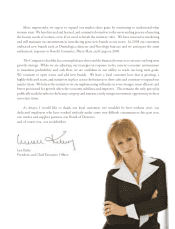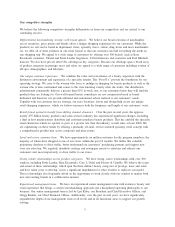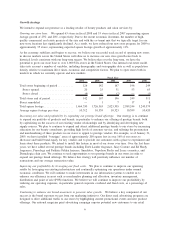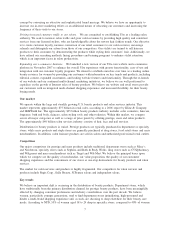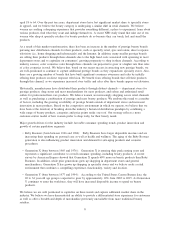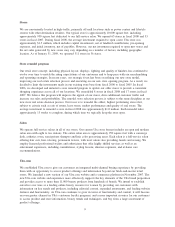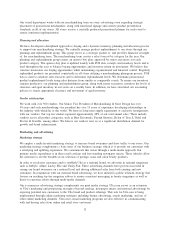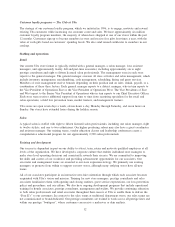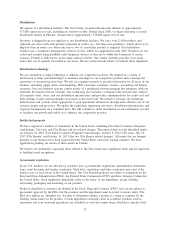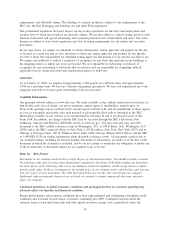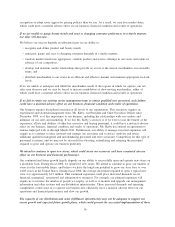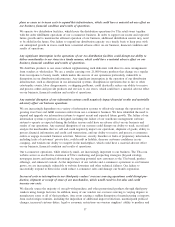Ulta 2008 Annual Report Download - page 14
Download and view the complete annual report
Please find page 14 of the 2008 Ulta annual report below. You can navigate through the pages in the report by either clicking on the pages listed below, or by using the keyword search tool below to find specific information within the annual report.aged 18 to 64. Over the past ten years, department stores have lost significant market share to specialty stores
in apparel, and we believe the beauty category is undergoing a similar shift in retail channels. We believe
women are seeking a shopping experience that provides something different, a place to experiment, learn about
various products, find what they want and indulge themselves. A recent NPD study found that nine out of ten
women who shop at specialty retailers for beauty products do so because they can touch, feel and smell the
products.
As a result of this market transformation, there has been an increase in the number of prestige beauty brands
pursuing new distribution channels for their products, such as specialty retail, spas and salons, direct response
television (i.e., home shopping and infomercials) and the Internet. In addition, many smaller prestige brands
are selling their products through these channels due to the high fixed costs associated with operating in most
department stores and to capitalize on consumers’ growing propensity to shop in these channels. According to
industry sources, color cosmetics sales through these channels are projected to grow at a higher rate than sales
of color cosmetics in total. We believe that, based on our recent success in attracting new prestige brands, we
are well-positioned to continue to capture additional prestige brands as they expand into specialty stores. Also,
there are a growing number of brands that have built significant consumer awareness and sales by initially
offering their products on direct response television. We benefit from offering brands that sell their products
through this channel, as we experience increased store traffic and sales after these brands appear on television.
Historically, manufacturers have distributed their products through distinct channels — department stores for
prestige products, drug stores and mass merchandisers for mass products, and salons and authorized retail
outlets for professional hair care products. We believe women are increasingly shopping across retail channels
as well as purchasing a combination of prestige and mass beauty products. We attribute this trend to a number
of factors, including the growing availability of prestige brands outside of department stores and increased
innovation in mass products. Based on the competitive environment in which we operate, we believe that we
have been at the forefront of breaking down the industry’s historical distribution paradigm by combining a
wide range of beauty products, categories and price points under one roof. Our strategy reflects a more
customer-centric model of how women prefer to shop today for their beauty needs.
Major growth drivers for the industry include favorable consumer spending trends, product innovation and
growth of certain population segments.
• Baby Boomers (born between 1946 and 1964): Baby Boomers have larger disposable incomes and are
increasing their spending on personal care as well as health and wellness. The aging of the Baby Boomer
generation is also influencing product innovation and demand for anti-aging products and cosmetic
procedures.
• Generation X (born between 1965 and 1976): Generation X is entering their peak earning years and
represents a significant contributor to overall consumer spending, including beauty products. A recent
survey by American Express showed that Generation X spends 60% more on beauty products than Baby
Boomers. In addition, while prior generations grew up shopping in department stores and general
merchandisers, Generation X has grown up shopping in specialty stores and we believe seeks a retail
environment that combines a compelling experience, functionality, variety and location.
• Generation Y (born between 1977 and 1994): According to the United States Census Bureau data, the
20 to 34 year-old age group is expected to grow by approximately 10% from 2003 to 2015. As Generation
Y continues to enter the workforce, they will have increased disposable income to spend on beauty
products.
We believe we are well positioned to capitalize on these trends and capture additional market share in the
industry. We believe we have demonstrated an ability to provide a differentiated store experience for customers
as well as offer a breadth and depth of merchandise previously unavailable from more traditional beauty
retailers.
8



